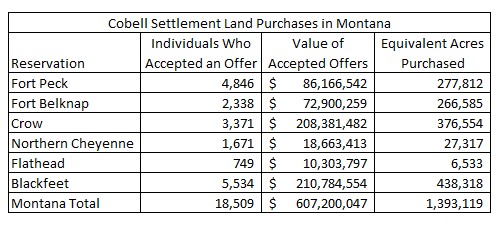Three years ago, I wrote a post about a $280 million dollar Agricultural Land Purchase in Montana. That purchase was part of the 2009 Cobell v. Salazar Settlement. The settlement provided $1.9 billion dollars to purchase fractional ownership interests from tribal members on Indian Reservations nationwide. The program makes offers to purchase an individual’s ownership interest in a tract of land based on appraised value. If an offer is accepted by the owner then their interest in the land is transferred to the local tribal government and the individual receive the one-time payment. The offers are made one reservation at a time. In Montana, Fort Belknap, Fort Peck. Blackfeet, Flathead, Crow and Northern Cheyenne Reservations participated in the program. Over 18,500 individuals owning reservation land in Montana accepted offers. The total acreage purchased by the program in Montana was equivalent to 1,393,119 acres. The average value of the land was $436 per acre. Total payments for Montana land owners was $607,109,697. This represents almost a third of the entire settlement. About $200 million of the original $1.9 billion remains to fund additional purchases over next the 18 months. However, based on the implantation schedule it is unlikely that additional offers will be made in Montana.
Who benefits from this program?
Land Owners
Selling trust land has historically been a more cumbersome process than selling non-reservation land. This partly due to a restrictions on who can purchase trust land, appraisal requirements and the fractionalized ownership structure made it difficult to obtain complete ownership in a tract. As result, an opportunity to sell land to an eligible buyer is rarer than for off reservation land. Exchanging an illiquid asset (land) into a liquid asset (cash) may also be beneficial for the landowners choosing to accept an offer. Since, the option to sell an ownership interest was voluntary it hard to imagine that any landowners are worse off as a result of the program.
Local Businesses
Over $600 million of assets were essentially converted to cash for landowners that accepted offers as part of the program. I am not aware of any statistics on how these funds were utilized by each seller but at least some of these funds were spent at local, regional and national businesses providing a boost to their profitability in the short term.
Local Tribes
The local tribes (and their members) are likely the biggest beneficiaries of the program in the long term. The program purchased ownership interests in land with federal funds and then transferred ownership of these interests to the tribes where the land is located. Any future revenue (such as from a grazing lease) from these lands will now be an asset of the tribe and available to fund tribal government activities.
Future Land Management
The trust land with fractionalized interests fall under the management of the BIA for the benefit of the individual land owners. The Cobell Settlement was essentially based on problems with how BIA managed this process in the past. Each purchase through this program helped reduce the number owners BIA is tracking. Some tracts also reached the 50% or 100% tribal ownership levels which allows the tribe to take on a larger role in managing the land. Both of these developments could lead to more efficient management of these lands resulting in increased productivity of the land.

